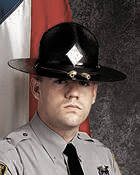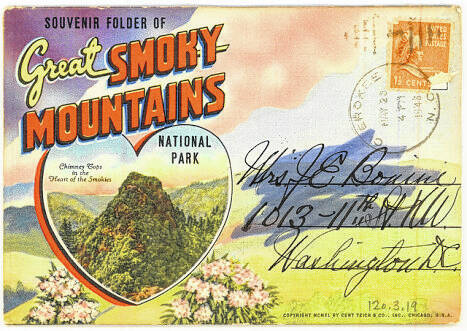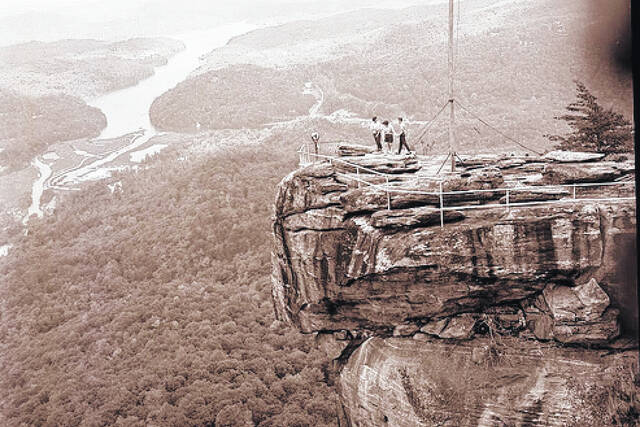THIS WEEKJ IN HISTORY
ROBESON COUNTY HISTORY
May 17, Wilton McLean’s Friends jubilant over prospects: A Robesonian story on May 17, 1924 (100 years ago) read as follows: RALEIGH — Members of “McLean for Governor” clubs, county managers and friends of the Robeson county candidate from counties in which he has spoken or just “stopped over” for a short time in his swing around the state, continue to write in of the fine impression A.W. McLean is: making upon the people wherever he goes. Raleigh headquarters force of the Lumberton man find themselves jubilant over the reports. May 18. School officials confident on short-term fix: The May 18, 2019 (five years ago) Robesonian carried the following: LUMBERTON — Despite its often rancorous and disorganized meeting this week, school leaders are confident that at least some of its short term problems, including the $2 million deficit, will be fixed. But solving Long-term issues, including closing small, Underperforming schools, are complex and difficult, they say.
May 20, Drug arrest made at local prison unit. The May 20, 1924 (50 years ago) Robesonian reported that an arrest for possession of marijuana with intent to distribute took place at rather unusual place Sunday afternoon — the Robeson County Prison Unit. It seems that Sgt. Kirby Ammons of the unit reported to the sheriff’s department that some visitors were trying to smuggle marijuana to inmates.
May 21, Two patrolmen honored by state for their service: The March 21, 2015 Robesonian (nine years ago) carried the following story: RALEIGH — Two Robeson County highway patrolmen have been recognized by the state Highway Patrol for exemplary Service. Michael J. Miles, who has served as a trooper for seven years, received the Highway Patrol Meritorious Award on Tuesday. In December he saved a 3-year-old South Carolina boy from an abductor. Charles Lewis, a weigh station operator, received the Samaritan Service Award for his “unselfish and compassionate actions” to save another man, the Highway Patrol said. In March, Lewis was working the weigh station when a passenger from a van approached him asking for help.
May 24, UNC Health plans $40 million enhancement of women’s services: The May 24,m 2023 Robesonian (one Year ago) published the following: LUMBERTON — Over the next two years, UNC Health Southeastern plans to enhance its women’s health services through a multi-phased initiative to upgrade its hospital services for women, mothers, and babies, as well as to consolidate its women’s health clinics into one combined setting.
NORTH CAROLINA HISTORY
May 18, Joseph McDowell, Not to Be Confused with Joseph McDowell: On May 18, 1795, Revolutionary War veteran Joseph McDowell died in Burke County at the age of 38.
The only son of “Hunting John” McDowell, a pioneer of Scotch-Irish descent who arrived in western North Carolina in the mid-1700s, Joseph was born on the family plantation, Pleasant Gardens, in what was then Burke County.
Because McDowell had a cousin of the same name, he was referred to as “Pleasant Gardens Joe” so as not to be confused with “Quaker Meadows Joe.” During the American Revolution, both men enlisted in a military unit under the command of their kinsman Charles McDowell and fought at the Battle of Kings Mountain.
There are discrepancies as to which Joseph led the troops at Kings Mountain, but it is most likely that Major Joseph McDowell (Pleasant Gardens) was under the command of Colonel Joseph McDowell (Quaker Meadows).
May 18, North Wilkesboro and the Roots of NASCAR: On May 18, 1947, the North Wilkesboro Speedway opened its doors to a crowd of more than 10,000 spectators who watched Fonty Flock win the first official race held there. The 5/8-mile oval dirt track was well-known for challenging the best of drivers.
Stock car racing fans and scholars have long acknowledged that the roots of the National Association for Stock Car Auto Racing (NASCAR) are closely tied to the tradition of illegal moonshine production. Races between “runners” evolved into spectator events. The North Wilkesboro Speedway was among the first tracks recognized by NASCAR during its inaugural year of 1949. NASCAR’s first finale took place there, with the crowning of the first points champion, Robert “Red” Byron, in October 1949.
The speedway often has been called to as “The House that Junior Built,” a reference to racing legend Junior Johnson who began his career there at age 16. Johnson earned four of his 50 career NASCAR victories there, and continued his success on the track as a team owner.
The last NASCAR race at North Wilkesboro, won by Jeff Gordon, was held on September 29, 1996, with more than 60,000 fans in attendance.
May 19, Elvis Upstages, Excites in Raleigh: On May 19, 1955, Hank Snow’s All Star Jamboree tour, featuring a new young talent named Elvis Presley, ended at Memorial Auditorium in Raleigh. It marked the beginning of the end of the touring relationship between the headliner, Faron Young, and featured player Presley. Young later recounted that each night of the tour Elvis got bigger and wilder crowds. Before intermission, each show included a new talent portion in which Presley took the stage, with the headliners performing after intermission.
As the tour progressed, fans began to shout for more Elvis during the other performances, and he was called back for encore after encore. In the early days of the tour Colonel Tom Parker, as booking agent, actually paid teenagers $5 apiece to scream for Presley. He used the publicity photographs to send to the newspapers in the next cities on the tour. Other performers on the tour recalled how much they discounted Presley and his odd onstage behavior. Most country singers thought that he was a fad who would quickly fade, but Presley soon found himself the headliner, and few established stars would agree to perform with him on a tour.
Following the war McDowell practiced law and served in the state legislature, as a delegate to two Constitutional Conventions and as an early member of the Board of Trustees of the University of North Carolina.
He married Mary Moffett and they had three children, John, James and Annie. McDowell County is named in his honor.
May 19, Rough Justice in the Backcountry, 1865: On May 19, 1865, a band of vigilantes led by Captain R. M. Sharpe began the siege of Fort Hamby in Wilkes County.
A simple log house in Wilkes County that between 18 and 30 United States army deserters called home, the fort took its name from its previous occupants, a group of “disreputable” women. The men used it as a staging point to plunder homes in Wilkes, Watauga, Caldwell and Alexander counties and to murder people who had been left defenseless by the war.
Led by a man with the surname of Wade, the band benefited from the lack of law and order in the region that followed Lee’s surrender in April 1865.
After a 22-man group of former Confederate soldiers unsuccessfully tried to capture Wade and his associates, Sharpe led two companies of local men to try and eliminate the group. Shots were fired back and forth all day and into the night. Only after two men set fire to the house did Wade and his men finally ask to surrender. Sharpe’s reply was:
We will shoot you.
Wade managed to escape, but four of his men were captured, tied to a stake, and executed. Inside the house, the victors found a wealth of stolen goods. Once the valuables had been removed, the house was burned to the ground.
May 19, Texas Oilman Enriched the State, the University: On May 19, 2008, Walter Royal Davis of Midland, Texas; Manteo; and Chapel Hill, died. The oil magnate turned philanthropist never attended a college class in his life but donated generously to North Carolina schools, to favorite causes and to those in need of help.
As a young man Davis engaged in the rough-and-tumble of the oil business and served a 90-day federal prison sentence in 1948 for failure to file income taxes. By 1952, he had launched a highly successful trucking operation to haul crude oil from wells to refineries. He parlayed those profits into real estate and, combined with his winnings at the blackjack and gin rummy tables, became fantastically wealthy. Over the course of his life he was married six times to four different women.
Thoroughly Texan and a friend of both Presidents Bush, Davis did not forget the Tar Heel State. He retired to North Carolina and formed strong political and personal friendships, notably with legislator Marc Basnight.
Louisburg College, Methodist University and churches and schools in his native Elizabeth City benefited from his gifts. As a trustee of UNC-Chapel Hill, he guided $32 million in state proceeds from utility sales to the construction of a library, completed in 1984, that bears his name.
May 20, Highway Patrol Outfitted in Morehead City: On May 20, 1929, the first candidates for the North Carolina State Highway Patrol reported to Camp Glenn in Morehead City. Charles D. Farmer, superintendent of equipment for the State Highway Commission, was selected to serve as captain and commanding officer. Nine lieutenants, one for each of the state’s Highway Division Districts, were appointed to assist in the administration of the patrol. The plan was to hire 27 patrolmen, three for each district. A total of 67 applicants were selected to attend the first highway patrol training school.
The courses for the first class of cadets included Motor Laws, Pistol Marksmanship and Geography of North Carolina. After six weeks, the students with the best records were appointed to the Highway Patrol. The novice patrolmen were issued uniforms and motorcycles. The nine lieutenants received Ford coupes, and Charles Farmer was given a Buick. The entire group embarked on a statewide tour in order to engender support for and confidence in the new program. The 1,028-mile tour took the men from Beaufort to Asheville and back to Raleigh, with many stops along the way. Concluding at the State Capitol, all 37 members of the force took their oaths of office and reported for duty.
May 21, Chimney Rock Acquired by the State, 2007: On May 21, 2007, the state of North Carolina purchased Chimney Rock Park in western Rutherford County from the Morse family, which had owned and operated the tourist attraction for more than a century.
Two months later, the General Assembly merged the thousand-acre park with neighboring Hickory Nut Gorge State Park and renamed the entire 5,942-acre tract Chimney Rock State Park. The new state park was named after the 315-foot granite spire that overlooks Lake Lure and offers spectacular views of the 14-mile gorge carved by the Rocky Broad River.
In 1902, Dr. Lucius B. Morse, a Missouri physician diagnosed with tuberculosis and looking for a healthier climate, bought 64 acres on Chimney Rock Mountain, including the “Chimney” and cliffs, from Jerome B. “Rome” Freeman. Freeman already had built a stairway to the mountaintop and opened it to the public in 1885.
Over the years, the Morse family constructed a 258-foot elevator shaft inside the mountain, opened a gift shop and snack bar at the top, and developed a nature center and hiking trails, all while expanding the park’s size.
Today, the park is managed by the N.C. Division of Parks and Recreation.
May 21, Murder in Yanceyville Sparks “War”: On May 21, 1870, J. W. Stephens, a state senator and Freedman’s Bureau agent, was murdered by Ku Klux Klansmen in the basement of the Caswell County Courthouse in Yanceyville. On that Saturday there was a political rally near the courthouse. One of the people in attendance was J.W. ‘Chicken’ Stephens, despised by the local Ku Klux Klan chapter for his progressive attitudes towards blacks. Governor William W. Holden had tasked Stephens with investigating suspected Klan members, the same Klan members who had marked Stephens for death. Lured into the basement of the courthouse, Stephens was ambushed and stabbed; his body was left on a woodpile.
The murder, along with that of black town commissioner Wyatt Outlaw in Graham earlier that year, led Gov. Holden to declare martial law in Alamance and Caswell Counties. Holden, believing the area to be in a state of insurrection, called up the militia to occupy the area and settle the racial violence. The episode, which has become known as the Kirk-Holden War, led to Holden’s impeachment and removal from office in 1871.
May 21, Here’s to the Land of the Longleaf Pine: On May 21, 1957, the General Assembly adopted an official state toast.
The toast was first read by the Rev. Walter W. Moore in May 1904 in Richmond at a banquet hosted by the North Carolina Society of Richmond. Moore’s toast came from “The Old North State,” a poem, written by Leonora Monteiro Martin, which was reportedly commissioned for the event.
Martin, a writer who had lived in North Carolina, was living in Richmond with her husband, Harry Culver-Martin at the time.
Beginning in May 1904, lines of the poem appeared in newspapers in accounts of tributes and toasts given at other occasions. The poem became almost instantly ubiquitous in association with patriotic and nostalgic feelings for the state, and within a few years it appeared on postcards and in anthologies.
In the 1930s, Mary Burke Kerr, a music teacher in Sampson County, composed music for Martin’s poem, and in 1933 the General Assembly officially recognized Kerr’s composition with a resolution and requested that WPTF, a Raleigh radio station, began to play a recording to acquaint North Carolinians with it.
From that point, generations of North Carolina school children learned the song before the General Assembly officially recognized the combined creations of Martin and Kerr as the state toast in 1957.
The full text of the toast reads:
Here’s to the land of the long leaf pine,
The summer land where the sun doth shine,
Where the weak grow strong and the strong grow great,
Here’s to “Down Home,” the Old North State!
Here’s to the land of the cotton bloom white,
Where the scuppernong perfumes the breeze at night,
Where the soft southern moss and jessamine mate,
‘Neath the murmuring pines of the Old North State!
Here’s to the land where the galax grows,
Where the rhododendron’s rosette glows,
Where soars Mount Mitchell’s summit great,
In the “Land of the Sky,” in the Old North State!
Here’s to the land where maidens* are fair,
Where friends are true and cold hearts rare,
The near land, the dear land, whatever fate,
The blest land, the best land, the Old North State!
May 21, Hiwassee Dam, Five Years in the Making: On May 21, 1940, the Hiwassee Dam in Cherokee County generated power for the first time. The dam was built by the Tennessee Valley Authority and was one of the largest construction projects in the state at that time.
The Tennessee Valley Authority was one facet of the sprawling New Deal plan created by President Franklin D. Roosevelt. The goal of the TVA was to bring electricity, economic development and flood control to the Southern Appalachian region and, to achieve those aims, it recommend building dams and reservoirs along the Tennessee River and its main tributaries. The Hiwassee and the Fontana Dams were the two built in western North Carolina as part of that effort.
Work on the Hiwassee project began in July 1936, and it took a crew of 1,600 men nearly four years to complete. The building of the dam and reservoir led to the creation of Hiwassee Lake which is still used today for recreation.
At the time of construction the overspill dam was the nation’s tallest at 307 feet. The final cost of construction came in at $16.8 million, which would be about $282 million if built today.
May 22,North Carolinians Readied for Spanish-American War, 1898: On May 22, 1898, the 1st North Carolina Regiment was dispatched to Camp Cuba Libre in Jacksonville, Florida, for service in the Spanish-American War.
The regiment was raised earlier that month, and the troops trained at Camp Bryan Grimes in Raleigh. The camp was established near the State Fairgrounds after the Raleigh Chamber of Commerce donated land for it along Hillsborough Street, then on the western outskirts of the city. The camp consisted of nearly 300 tents, laid out in rows. Eventually, as the camp took in more volunteers, Camp Dan Russell was established on the fairgrounds to accommodate the 2nd Regiment.
After arriving in Florida, the troops stayed there throughout the war, which ended in August 1898, and were subjected to poor conditions, mass desertions and a lack of supplies. The only service abroad the unit would see was four months of a guard duty in Cuba between December 1898 and March 1899.
North Carolina’s other two regiments during the war were plagued by outbreaks of disease and dismal conditions. They were stationed in the several locations around the southern U.S. but did not go to Cuba.
May 22, A National Park in the Great Smoky Mountains: On May 22, 1926, President Calvin Coolidge signed the bill that established the Great Smoky Mountains National Park. The process had been difficult, taking many years and much negotiation before the park became one of the 59 parks in the national system.
The idea to create a park in the mountains of North Carolina and Tennessee started in the late 1890s. Initially there was a debate over whether to make the public land preserve in this area a national park or a national forest. The main difference is that in a national forest, timbering of the land is permissible, while in a national park, scenery and resources are protected.
Once Coolidge signed the bill establishing the park, supporters had to find the funds to purchase an initial 150,000 acres before the Department of the Interior would assume responsibility. By 1928, $10 million had been raised by individuals, the North Carolina and Tennessee state legislatures, private groups and a campaign by school children. Thousands of small farms and homesteads as well as large timber corporations had to be bought out. The park was dedicated in 1940 and today it is the nation’s most visited park.
You can also check out the 1927 North Carolina law that authorized the purchase of land for the park online in the digital collections of the State Archives and State Library.
May 22, Jennette’s Pier: A Nags Head Institution: On May 22, 1939, work began on Jennette’s Ocean Pier in Nags Head, the first fishing pier on the Outer Banks.
The 750-foot wooden structure was built by Elizabeth City’s Warren Jennette, Sr., who purchased the former site of Camp Weaver, a WPA transient camp that housed workers who built sand dunes in the area. Some buildings were converted into overnight accommodations for fishermen.
The pier opened for business that summer with a snack bar, bait stand, guest rooms and restrooms for the public. Located across from Sam and Omie’s restaurant and near Whalebone filling station, the pier helped establish the business district in South Nags Head.
Jennette’s Pier suffered damage from sea worms, nor’easters, hurricanes and even a wayward shipwreck, and was rebuilt a number of times. But it was Hurricane Isabel in 2003 that caused its final demise. A new 1,000-foot state-of-the-art green pier with educational exhibits, wind turbines and concrete pilings was built to replace the old pier.
The new pier was dedicated in May 2011, with Governor Beverly Perdue taking part in the opening celebration. Now a facility of the North Carolina Department of Natural and Cultural Resources, Jennette’s Pier hosted nearly 200,000 anglers and sightseers last year.
May 23, Vietnam Monument at State Capitol Dedicated 1987: On May 23, 1987, the North Carolina Vietnam Veterans Memorial was dedicated on the grounds of the State Capitol in Raleigh. Entitled “After the Firefight,” the memorial honors the more than 206,000 men and women of the state who served in the Vietnam War.
Designed by Abbe Godwin of Colfax in Guilford County, the monument depicts two soldiers carrying a wounded comrade to a nearby landing zone to await medical help. The clothing and equipment of the soldiers portrayed were sculpted from items loaned to the artist by Vietnam veterans.
During the four years she worked on the project, Godwin immersed herself in the conflict, collecting artifacts, reading histories and literature from the period extensively and talking to Vietnam veterans.
The monument was the first on the Capitol grounds to be authorized since the World War II-era and is the first to be sculpted by a woman. It is also the first on Union Square to depict an African American.
May 24, Dramatist Lula Vollmer, Acclaimed for “Sun-up:” On May 24, 1923, Moore County native Lula Vollmer’s play “Sun-up” premiered on Broadway. Her first and most successful drama, “Sun-Up” depicted people of the southern mountain region. She donated her royalties of more than $40,000 to help educate them.
Born in 1898 and educated at what later became Asheville College, Vollmer went to New York after graduation in 1918 to try to sell the play. Although she worked for the Theatre Guild as a box-office clerk, the Guild joined other producers in rejecting “Sun-Up” until it was produced at the Provincetown Theater.
Subsequently it was performed in Chicago, London, Amsterdam, Paris and Budapest.
In 1925, “Sun-Up” was published in book form. Between 1923 and 1946, Vollmer wrote many other plays, among them “The Shame Woman,” “The Dunce Boy,” “Trigger” and “Sentinels,” although none had the commercial success of her first.
Except for Paul Green, Vollmer had more plays produced in New York than any other North Carolina dramatist. Grant Wood, famous for his painting American Gothic, was scene designer for one of her early works.
Vollmer also wrote a variety of radio serials and in later years wrote short stories for the Saturday Evening Post, Collier’s Magazine and other magazines.
She died in 1955.
May 24, Last Royal Governor Ruled from Offshore: On May 24, 1775, Josiah Martin, the last royal governor of North Carolina, fled Tryon Palace under cover of darkness. In 1774, delegates to North Carolina’s First Provincial Congress recommended that counties form committees of safety, a move to supplant royal authority. Fearing that the cannons on the palace grounds might be used in an insurrection, Martin had them removed in May 1775.
Abandoning the palace, Martin went from New Bern to Fort Johnston, at the mouth of the Cape Fear River, where several English warships lay at anchor. He described the fort as “a wretched little place.”
Receiving reports that the Wilmington Committee of Safety planned to attack the fort and seize him, Martin took refuge on the HMS Cruizer that was resting offshore. It was a wise move, since five days later, the militia, in Martin’s words, “wantonly in the dead hour of night set on fire and reduced to ashes the houses and buildings within the Fort.”
The Cruizer would remain Martin’s headquarters through the summer and fall. From aboard the ship, on Aug. 8, he issued his “Fiery Proclamation,” denouncing the safety committees.
May 24, The Short, Active Life of St. Philips Church at Brunswick Town: On May 24, 1768, St. Philips Anglican Church at Brunswick Town on the Cape Fear River was dedicated.
Efforts to construct the church began in 1754, but it sat unfinished until 1759 when Gov. Arthur Dobbs proposed to make it “His Majesty’s Chapel in North Carolina.” Construction of St. Philips was funded initially through two lotteries and the sale of goods from the capture Spanish privateer, La Fortuna. Rev. John McDowell became the full-time minister for St. Philips Parish and received a small house and 300 acres of land nearby.
Construction was delayed many times and for many reasons, but Dobbs continued to push the project. In 1763, the 73-year-old governor married 15-year-old Justina Davis in the still unfinished church, and when he died in 1765 he was buried inside the structure.
Gov. William Tryon also took an interest in the church’s completion, seeing the project through to its finish in 1768. The parish was never very large and the church was not destined for a long life. Much of it was destroyed when the British sacked the town in 1776; only the four walls remain.
NATION AND WORLD HISTORY
May 19, Plans for D-Day invasion formed: In 1943, in his second wartime address to the U.S. Congress, British Prime Minister Winston Churchill pledged his country’s full support in the fight against Japan; that evening, Churchill met with President Franklin D. Roosevelt at the White House, where the two leaders agreed on May 1, 1944 as the date for the D-Day invasion of France (the operation ended up being launched more than a month later).
May 20, Charles Lindbergh takes off on solo flight to France: On May 20, 1927, Charles Lindbergh took off from Roosevelt Field on Long Island, New York, aboard the Spirit of St. Louis on his historic solo flight to France.
May 21, Amelia Earhart lands in Ireland: In 1932, Amelia Earhart became the first woman to fly solo across the Atlantic Ocean as she landed in Northern Ireland, about 15 hours after leaving Newfoundland.
May 22, Lyndon B. Johnson outlines “Great Society:” On May 22, 1964, President Lyndon B. Johnson, speaking at the University of Michigan, outlined the goals of his “Great Society,” saying that it “rests on abundance and liberty for all” and “demands an end to poverty and racial injustice.”
May 23, Bonnie and Clyde shot and killed: On May 23, 1934, bank robbers Clyde Barrow and Bonnie Parker were shot to death in a police ambush in Bienville Parish, Louisiana.
May 24, first night game in Major League Baseball: On May 24, 1935, the first Major League Baseball game to be played at night took place at Cincinnati’s Crosley Field as the Reds beat the Philadelphia Phillies, 2-1.
May 25, police kill George Floyd: On May 25, 2020, George Floyd, a Black man, was killed when a white Minneapolis police officer pressed his knee on Floyd’s neck for about 9 1/2 minutes while Floyd was handcuffed and pleading that he couldn’t breathe; Floyd’s death, captured on video by a bystander, would lead to worldwide protests, some of which turned violent, and a reexamination of racism and policing in the U.S.
This Week In History is compiled by Executive Editor David Kennard from Robesonian archives, the North Carolina Department of Natural and Cultural Resources and the Associated Press.











